For years I put off sharing a cabbage roll recipe. I don’t know why. Because the mere mention of cabbage rolls reminds me of my mum.
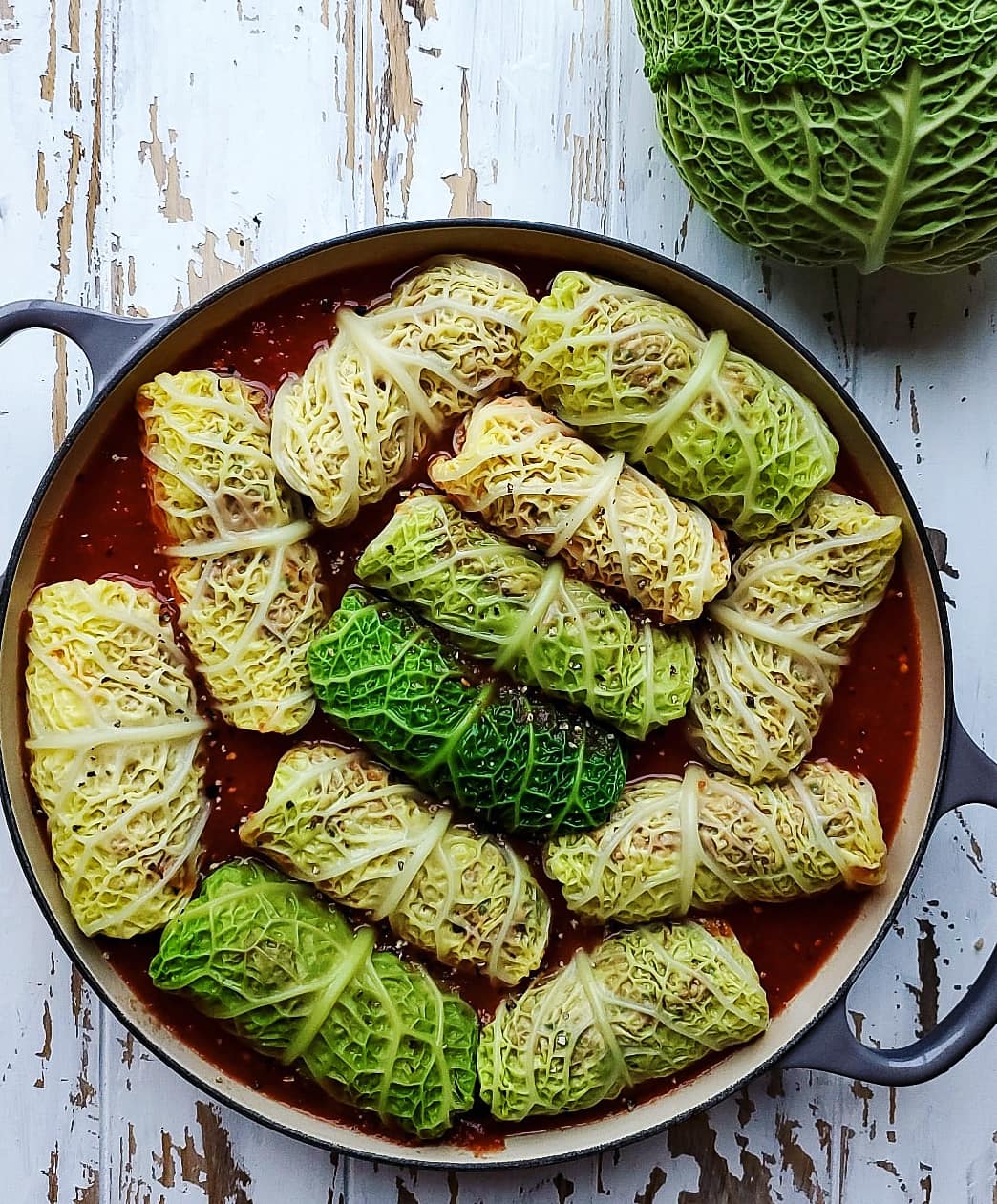 I can still see her slender fingers wrapping the softened cabbage leaves around the filling, and adding the little wrapped bundle to the pot with all the others. There was something so fascinating about watching her go through the entire process. For some reason, I always put off making them, thinking them too labour intensive. But really, in the end, they are no more fussy than making up a good lasagna, or batch of perogies.
I can still see her slender fingers wrapping the softened cabbage leaves around the filling, and adding the little wrapped bundle to the pot with all the others. There was something so fascinating about watching her go through the entire process. For some reason, I always put off making them, thinking them too labour intensive. But really, in the end, they are no more fussy than making up a good lasagna, or batch of perogies.
So here I go, sharing really the most fun you may have in the kitchen all winter. Because, yes, this is pure comfort food for a chilly winter’s eve. Not that a big batch wouldn’t be welcome at a shower, family reunion, potluck dinner etc, almost any time of the year. But for me, they do seem to come out during the winter months.
This is the perfect way to spend a grey afternoon. Inside, with the tunes playing, the cats sleeping, the snow whipping around outside the window, and perhaps a glass of wine to keep me extra company!
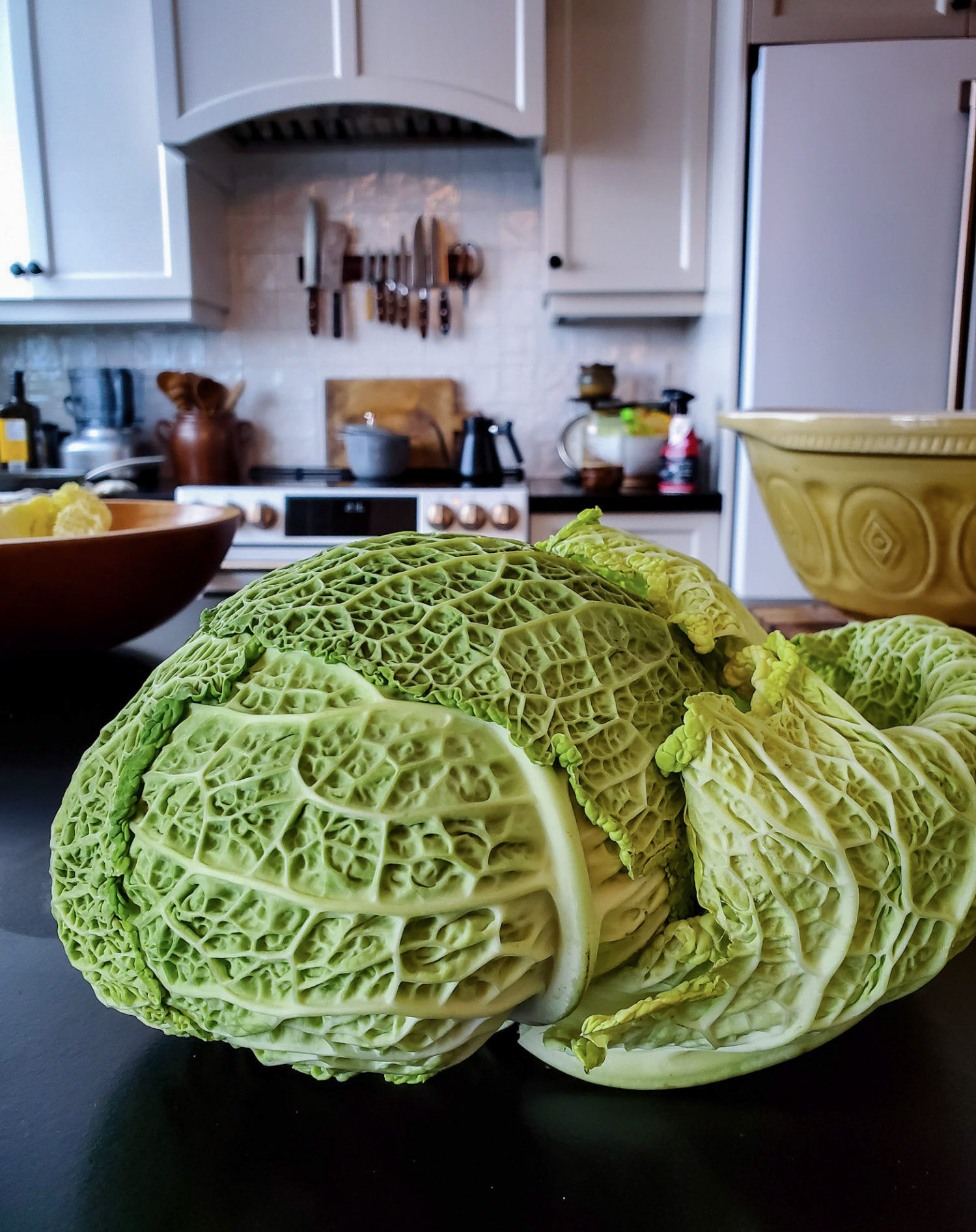
Which cabbage should I use for cabbage rolls?
We have a few options. The good ole green cabbage will work just fine. So will Napa cabbage, even Swiss chard will work great. But for me, there is no choice. It must be Savoy Cabbage. This is the one with the lacy, wrinkly, ruffled leaves. They are usually darker green on the outside, and lighten up as you start pulling them away. Savoy cabbage is also known as Winter cabbage. The leaves are softer and a bit more pliable, so in the end, they wrap around the filling most beautifully. And this is key, the leaves must be softened before any filling can happen. So this takes us to the next question:
How to soften the cabbage for cabbage rolls?
There are so many different methods that grandmas have passed on down through the years. Some suggest freezing the cabbage so that when it thaws, the leaves will be ready to go. But I find that this sometimes degrades the leaves, not leaving them all consistent, and some even too mushy to work with. There is the blanche the whole cabbage method as well. This involves removing the core, and placing the entire head of cabbage into a pot of boiling water for a few minutes till the leaves have softened sufficiently. Again, I find that this leaves us with some leaves softer than others. Don’t even get me started on using the microwave!
So this is what I do: First I remove the outer leaves which will pull away nicely from the core. Discard the top one or two if they don’t look pristine. Keep removing, going around the core as long as the leaves pull gently away. As we get further in, the leaves will be attached more firmly, so a little help from a sharp knife right against the core where the leaf attaches is all you need. Keep going till all the leaves are removed. Towards the very end, the core will just pull away with a gentle tug.
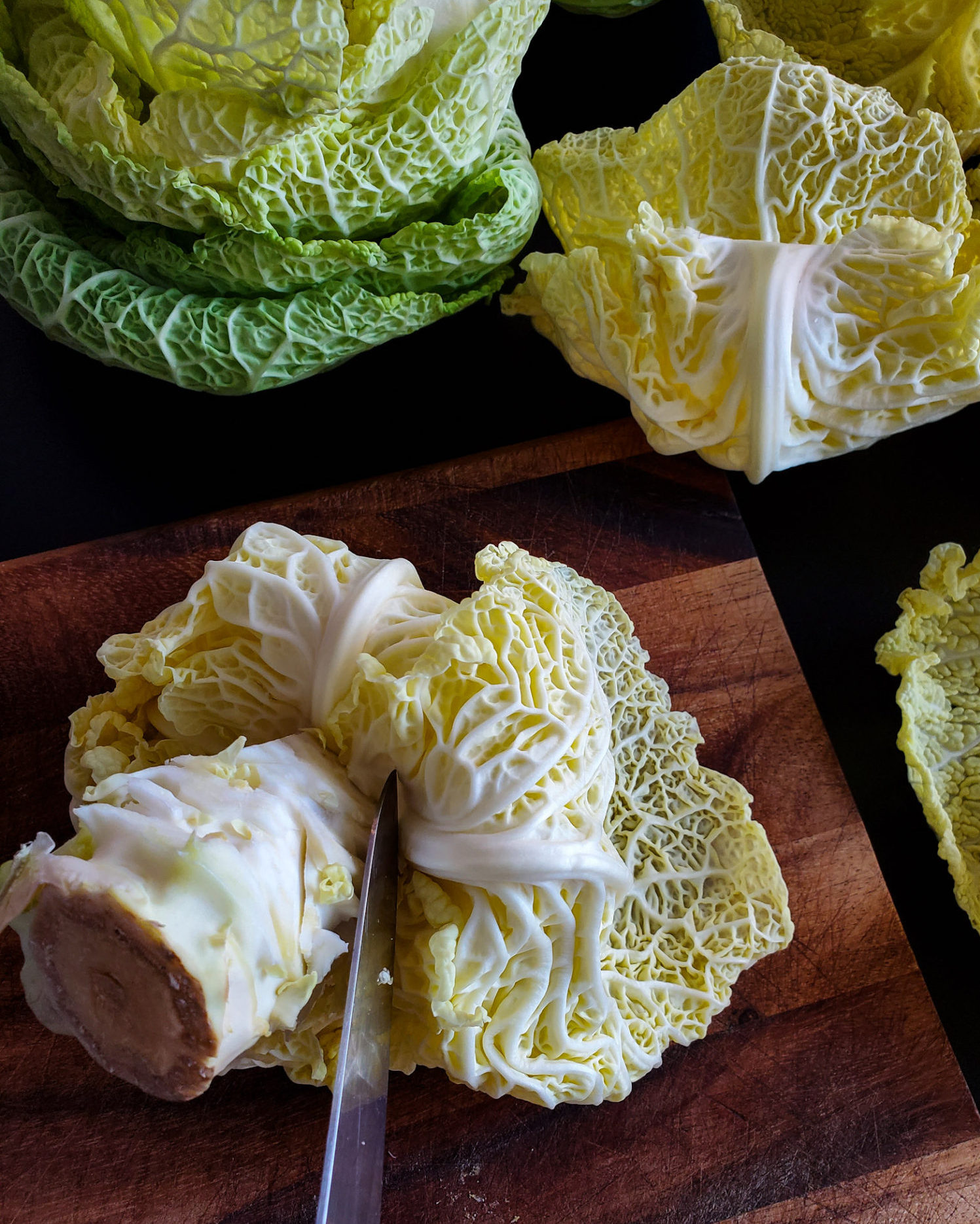
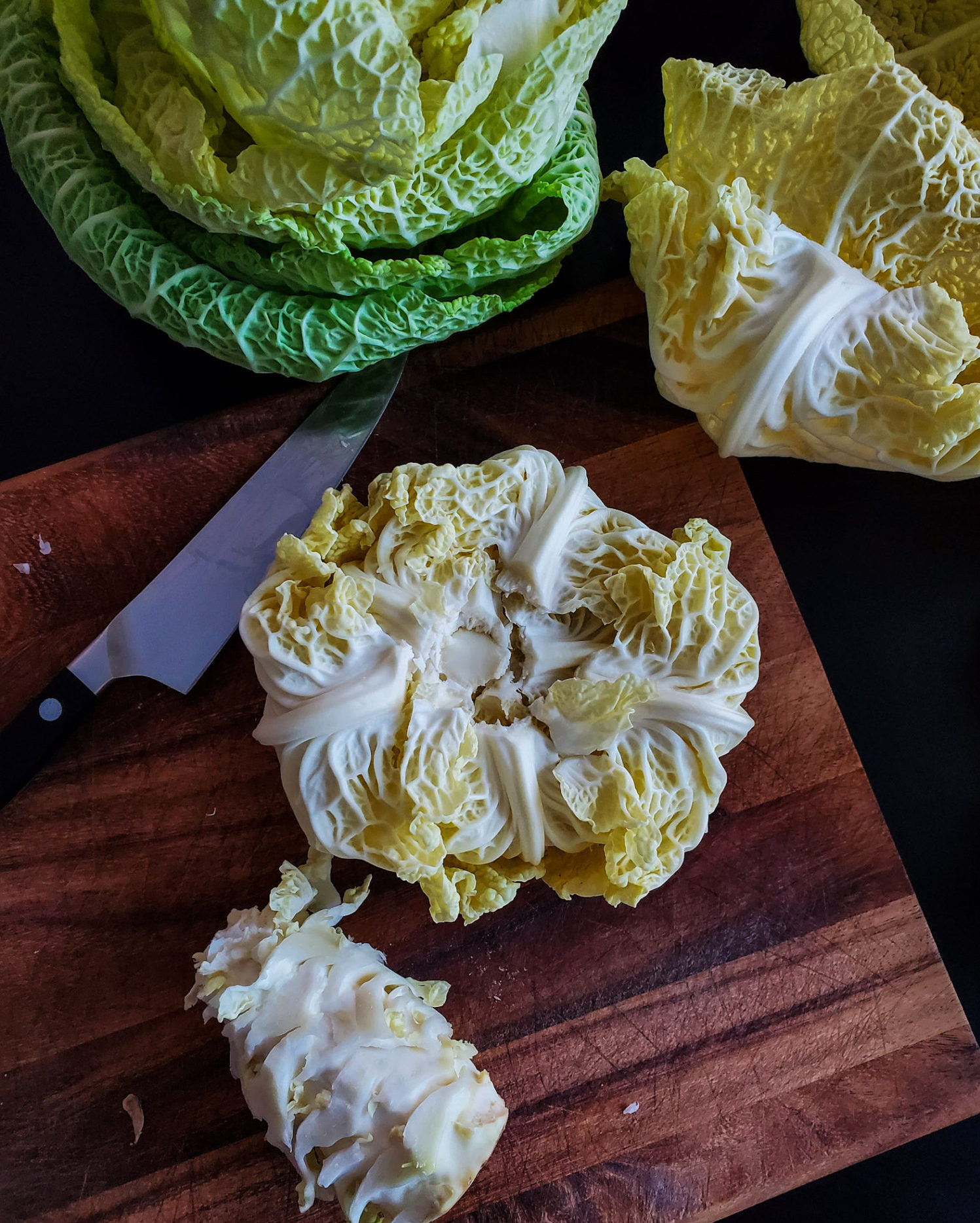
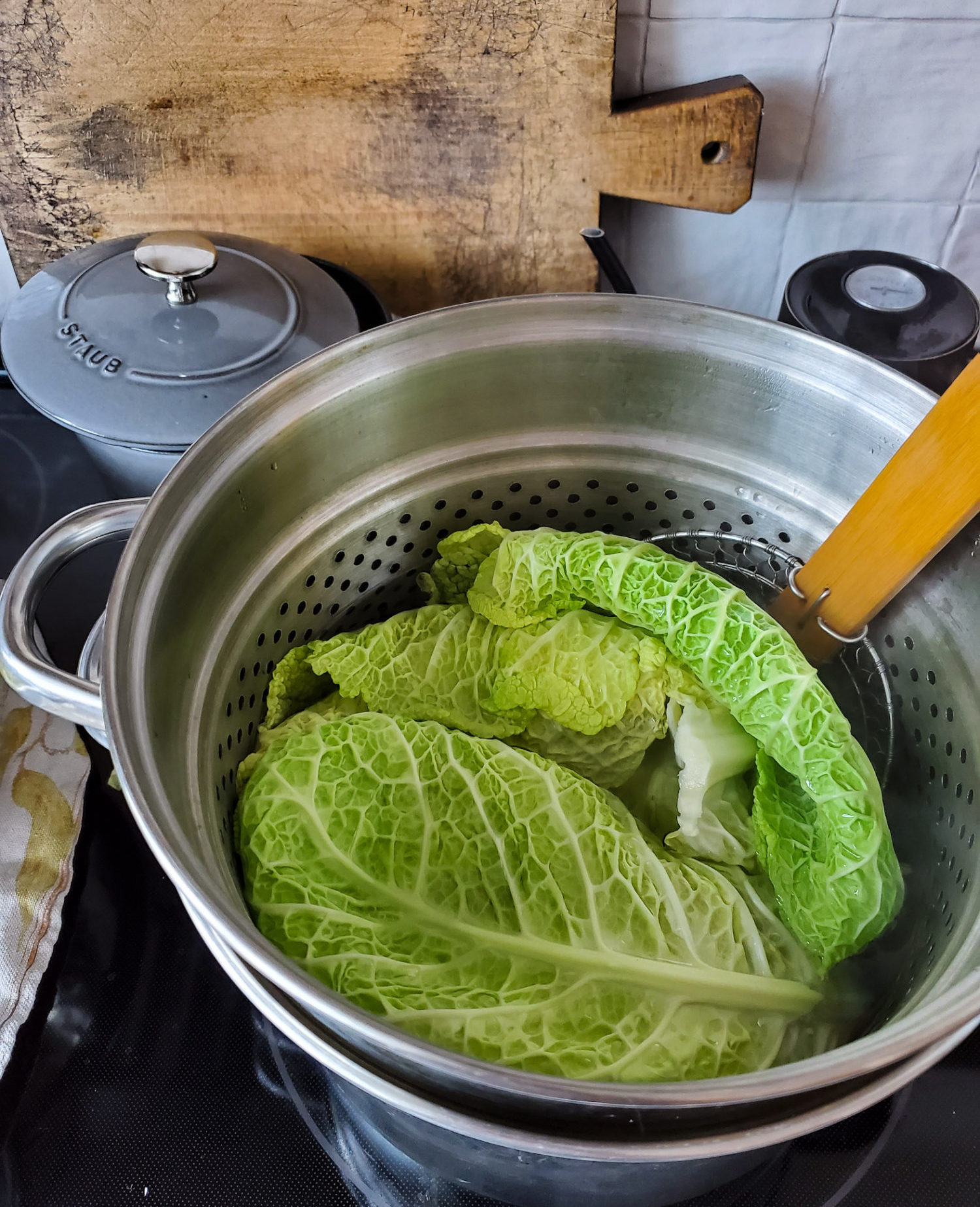
I use my pasta pot (the one with a large colander attachment that fits right inside. Once the salted water has come to a rolling boil, I add the leaves, as many as will fit comfortably. After a few minutes I pull up on the colander and transfer the leaves to a towel to dry off. I repeat till all the leaves have been blanched. Dry them all off well, and the leaves are ready to go. The really small leaves will line the bottom of the dish where the cabbage rolls will be baking, so none of the leaves are wasted. But don’t get rid of the water. You’ll see why in a minute.
How to remove the thick rib from the cabbage leaves and then stuff them?
Place a dried leaf in front of you on a cutting board. Using a sharp knife, cut close along either side of the centre rib, about 1 1/2 or so inches up. Trim across the rib to remove it completely. You are now left with loose leaf on either side, and the rest of the rib will be soft enough to roll up. It will look kind of like a triangle. Right above this triangle is where you will place the filling. Place about 1/2 cup of filling in the lower part of the leaf (see photo) and fold either side of the leaf over the filling. Take the two triangle bits of leaf at the bottom and fold them up and across each other. Now firmly roll up the leaf. Place it, with the opening at the bottom and place it on a baking sheet till you have finished them all. I find that an average Savoy cabbage gives us 12 or so good leaves to work with. So one cabbage will make up one batch of this recipe.
The filling for Cabbage Rolls:
While there are so many opinions of what should go into the filling, I will just say, my mum always had meat and rice. As to the seasonings, I was too little or disinterested to pay attention, but I do know that her filling was NEVER bland. I like to add paprika, white pepper and nutmeg beyond the basic salt and pepper. And along with parsley, I will always add a bit of dill, it is just so evocative of my mum’s cooking. I sauté the onions and garlic first, just to remove their harsh edge. But my most important tip for you: Never start filling the cabbage leaves until you have taken a small amount of the filling and sautéed it up in a skillet first. This way you can taste what the filling will be like. No sense going through all the work of rolling and baking these, only to find out that you would have liked more paprika! Once you are happy you can move on with filling the cabbage.
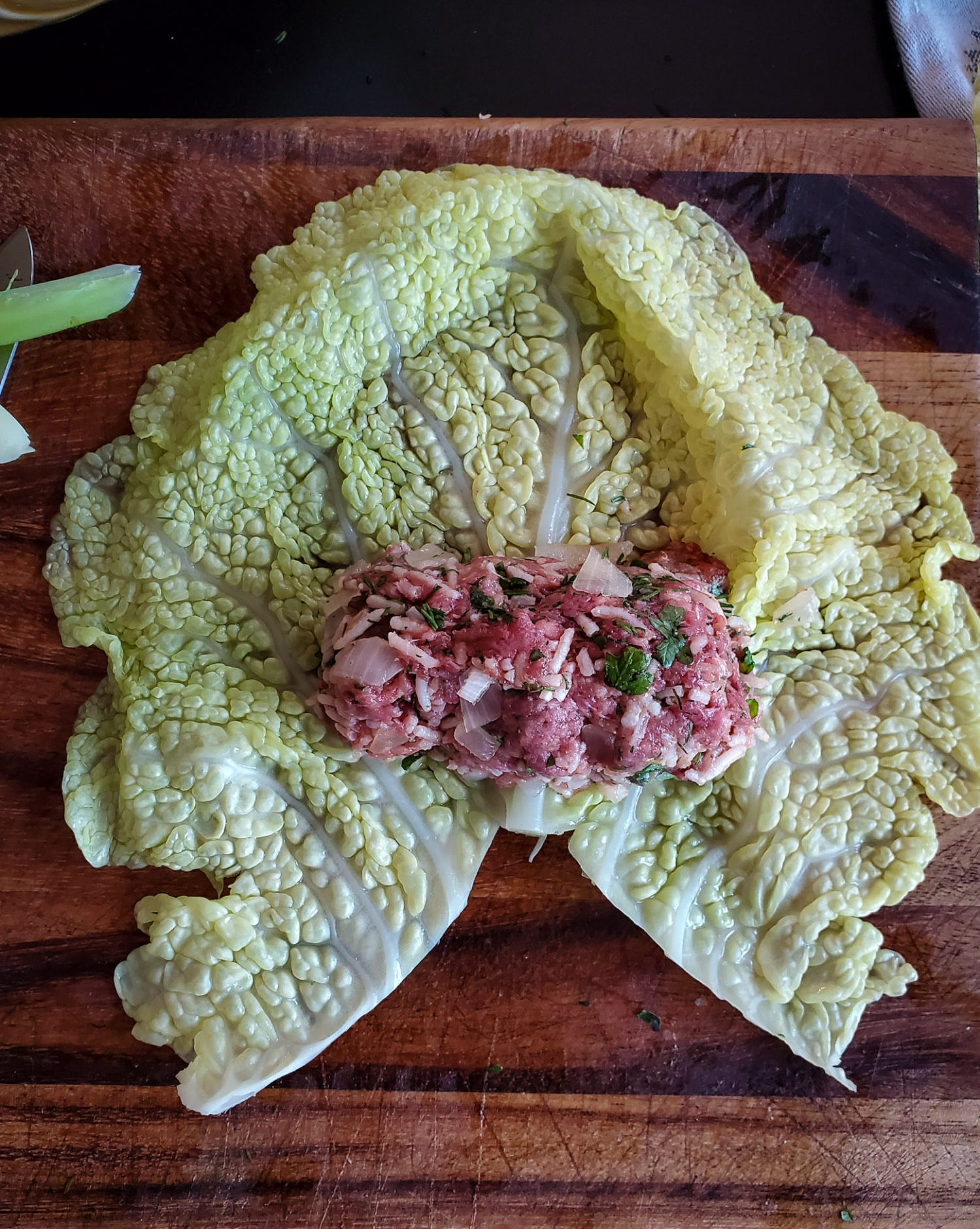
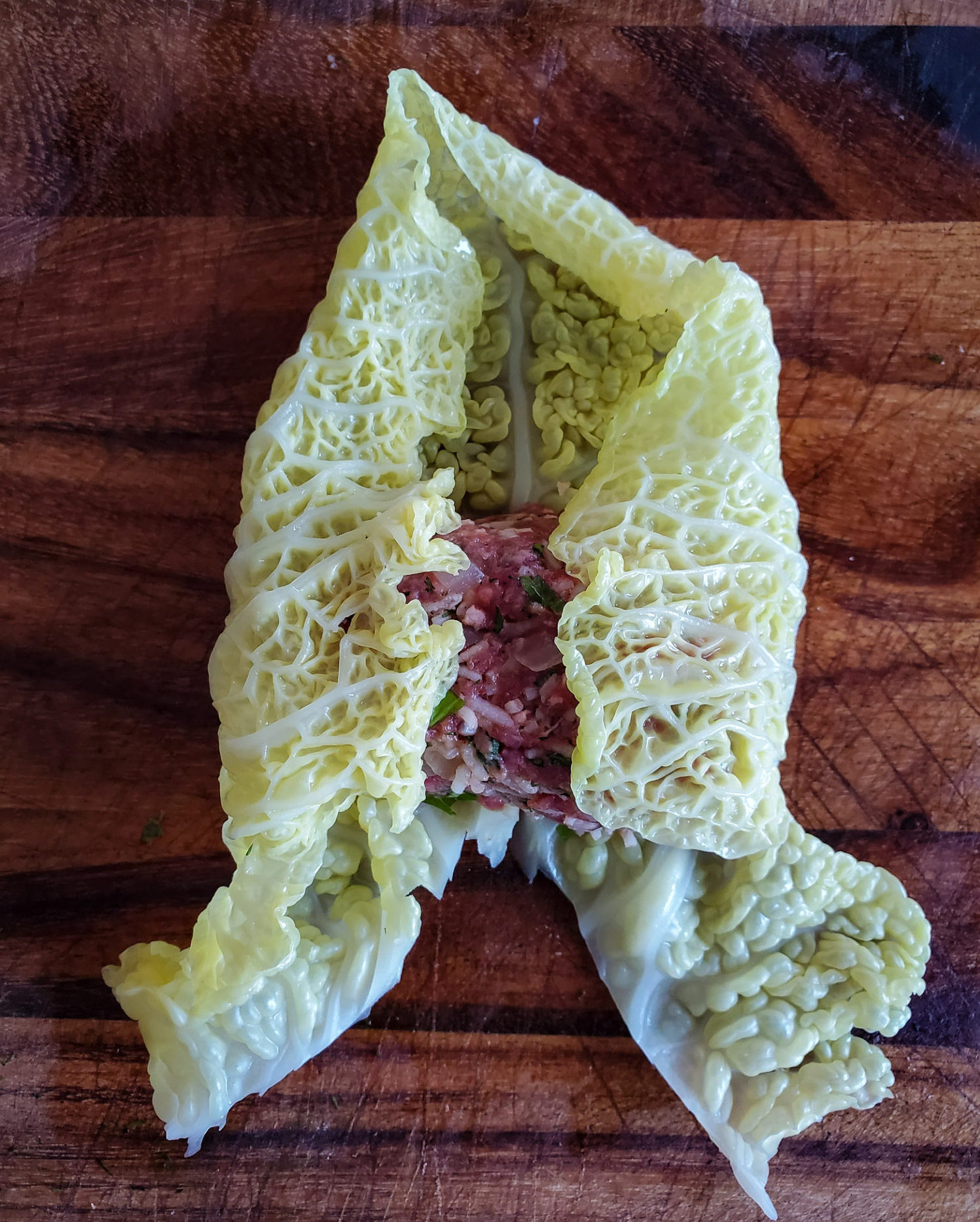
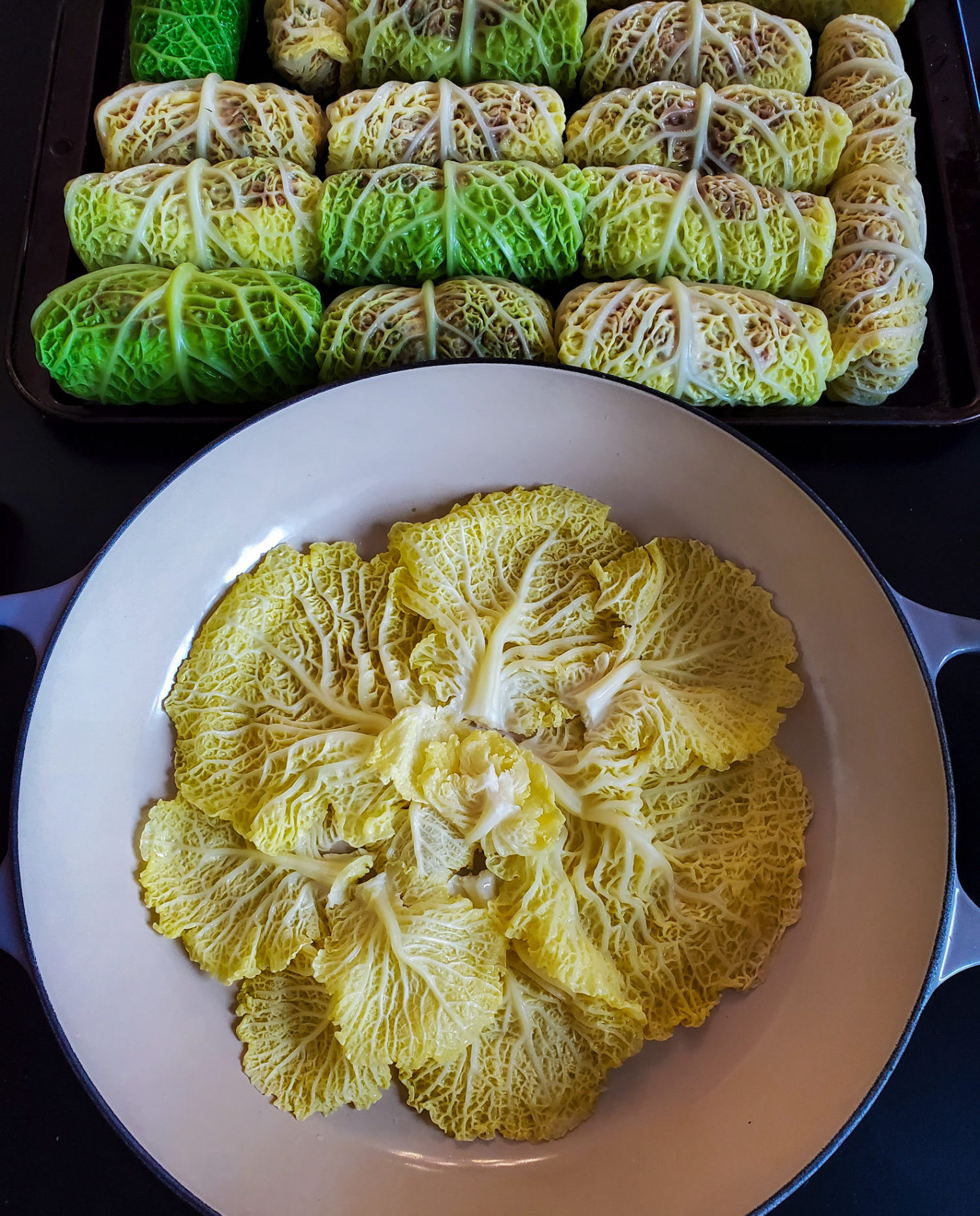
My mum used to use canned tomato juice for the braising liquid. I use a combo of homemade tomato passata (or a whole large jar of whole tomatoes that you will purée) along with the reserved water that you blanched the cabbage in. This gives extra flavour, and makes good use of that wonderful liquid in the pot. Nestle the cabbage rolls closely in a dutch oven or braiser, in one layer. I find that a large braiser is perfect for this. Because in the end, cabbage rolls are really a braised dish. Which just means that the meat (or in this case, cabbage rolls) are mostly covered in liquid of some sort, and the liquid simmers away, softening and cooking what it is surrounding. The liquid shouldn’t entirely cover the rolls, or else this would be boiling them. You want them to breathe as well, and the built up steam from the liquid will fall back down from the lid of the pot you are using and settle down and cook the rolls from above as well.
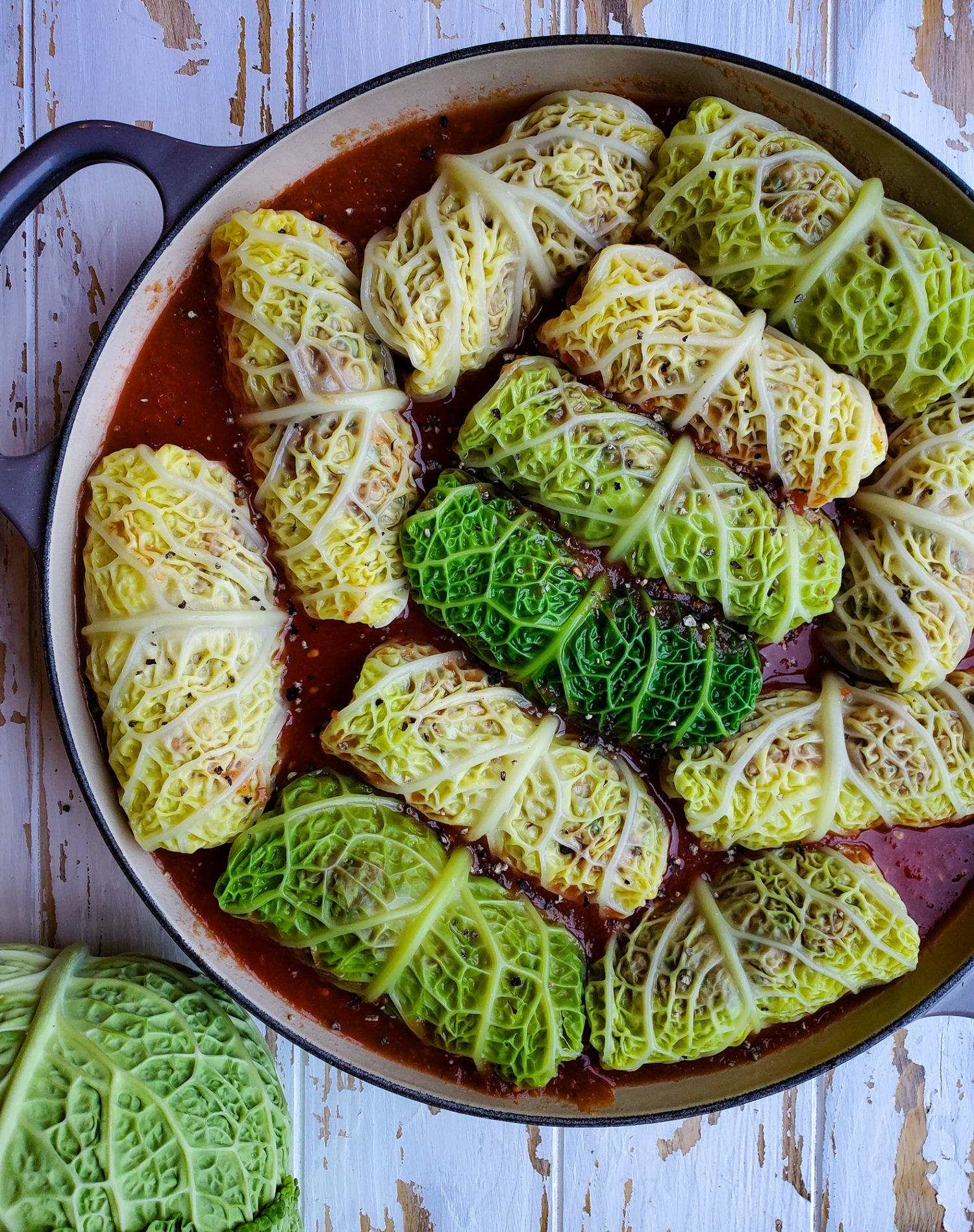
Cook low and slow. In about an 1 1/2 hours, you will have softened stuffed cabbage rolls with a lovely gravy to nestle onto fluffy mashed potatoes. Good ole fashioned comfort food. Just add some sour cream! And beer!
My final tip: Make a double batch! If you are going to go through all the work of making 12 or so cabbage rolls, you might as well make extra to freeze.
They freeze perfectly. Just put some of the braising liquid into a freezer safe container. Nestle the cabbage rolls into the container(s) and freeze till needed. Thaw in the fridge over night and cook in the oven till done.
Now I’m already planning to take a batch out of the freezer, Jim loves Cabbage Rolls!
Here are some of my other favourite comfort foods, inspired by my mum: Mama’s Chicken and Rice Mama’s Sauerbraten with Spätzle Borscht Chicken Noodle Soup Käsespätzle, aka German Mac n Cheese
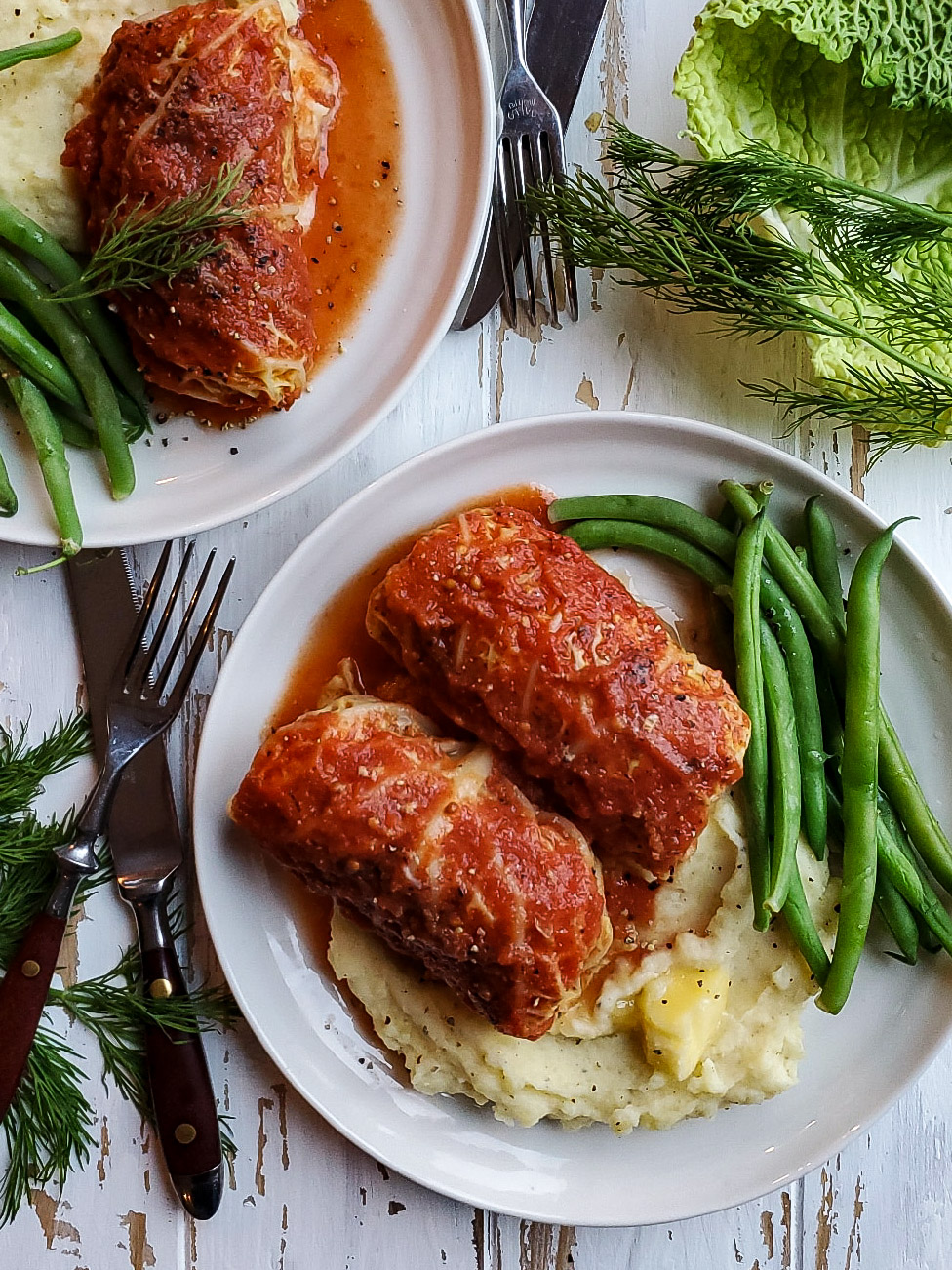
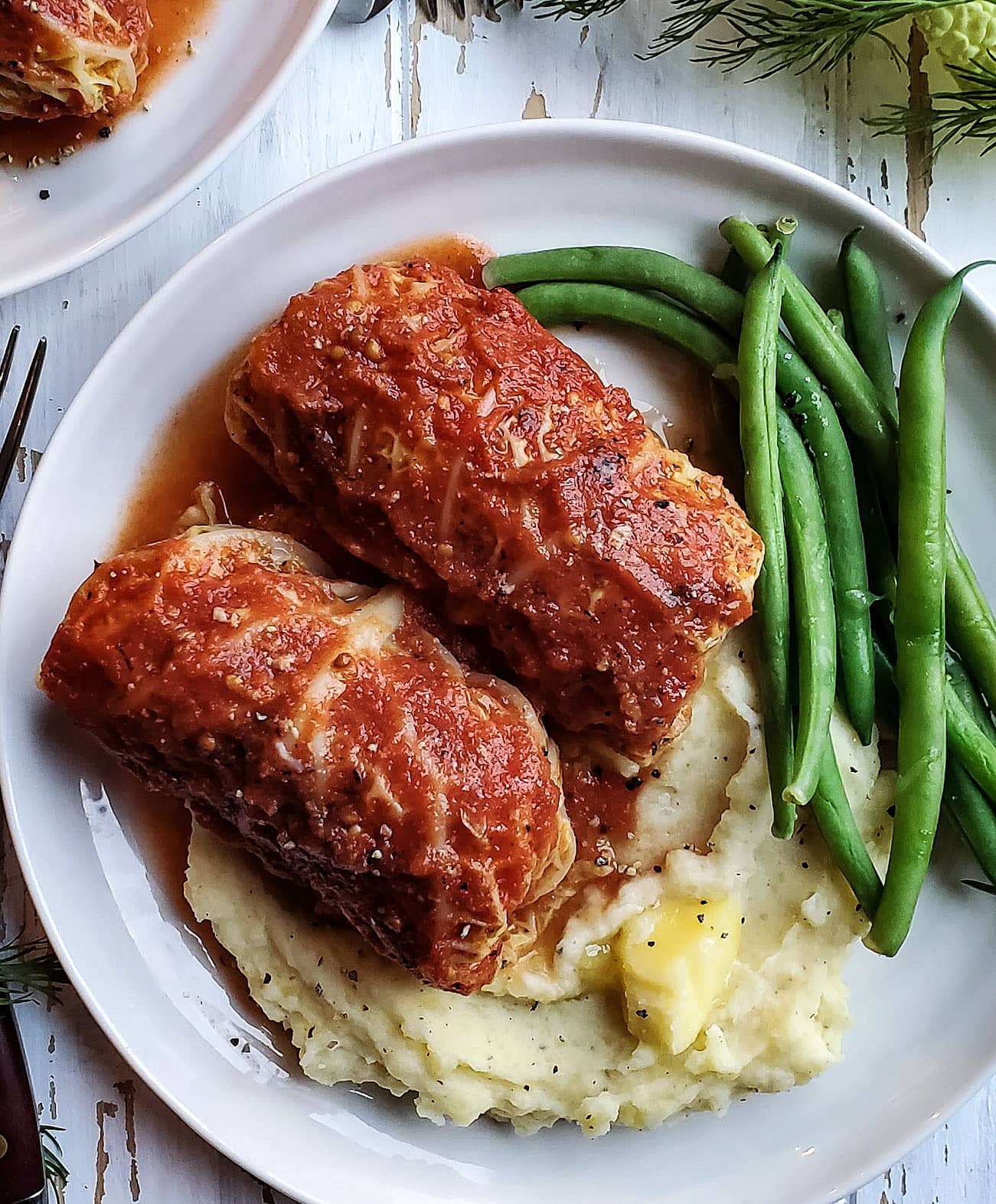
Cabbage Rolls, Like Mama Used to Make
Classic, comforting cabbage rolls. Nothing fancy, just good old fashioned goodness. Serve with mashed potatoes. Like mama used to make, almost!
Ingredients
- One head Savoy Cabbage will give you approximately 12 whole savoy cabbage leaves
- 3/4 cup long grain white rice rinsed under cold water
- 1 lb lean ground beef
- 1/2 lb ground pork
- 1 med yellow onion small dice
- 4 garlic cloves minced
- 1/2 cup parsley leaves chopped
- 1/4 cup dill leaves chopped
- 1 tsp salt
- 3/4 tsp black pepper
- 1/2 tsp white pepper
- 1/2 tsp paprika you can use sweet, smoked or hot, whatever you know your family likes
- 1/4 tsp nutmeg
- 2 eggs
- 1 large 796 ml 28 oz jar or can of whole or crushed tomatoes, or tomato passata
- 3 bay leaves
- 1 tsp salt
- 3/4 tsp pepper
- 3/4 tsp paprika
Instructions
Prep the Cabbage
-
Gently pull the leaves off the cabbage. At first they will come away easily. As they get closer to the core, use a sharp knife right along the core to release them.
-
Bring a large pot of salted water (about 3 tbsp of fine sea salt) to the boil. Gently slide the leaves into the hot salted water. Scoop the leaves out to drain once they become tender enough to be pliable (about 3-4 minutes) and set them aside on a tea towel. The thicker the rib in the middle, the longer they may need to stay in the water. Work in batches, depending on the size of your pot. Reserve the cooking water.
Prep the Filling
-
Place the rice and 1 1/2 cups of water into a medium size saucepan. Bring to a boil and then reduce the heat to a simmer and cover. Cook till the water is absorbed and the rice is tender, about 20 or so minutes. Check after 18 minutes. Remove the pot from the heat and leave it for 10 minutes, Then fluff it gently and leave it to cool a little. You can also use a rice cooker if you have one.
-
Meanwhile, sauté the chopped onion and garlic over medium heat in a medium skillet with a bit of olive oil. This is to soften the onions and garlic, taking away their raw 'edge' when adding them to the filling. Cook only till just softened, about 4-5 minutes. Save the skillet. Set the onions aside to cool.
-
In a large bowl, add the beef, pork, cooled rice, sautéed onion and garlic, parsley, dill, salt, pepper, ground white pepper, nutmeg and paprika and eggs. Mix until well combined.
-
Before filling the cabbage leaves, take a small amount of the filling, about a quarter's worth, and form a mini pattie. Sauté it the reserved skillet till just cooked through. Cool it down so that you can taste it. Do you like the seasonings? If so then move on to filling the leaves.
Make the Cabbage Rolls
-
Turn the oven on to 350 F (175°C).
-
Place one leaf flat on a cutting board in front of you. Using a sharp knife remove the bottom 1 1/2 inches or so of the large rib. This will leave you with a triangle shaped gap. Above this gap is where you will place the filling. Sprinkle the leaf with a pinch of salt and pepper.
Place ½ cup or so of the filling (squeeze gently to form a little mini log) then sit it into the lower centre of leaf. Fold the leaf’s side edges first, and then the bottom edges over the centre to enclose like and envelope. Roll until the ends are tucked under. Repeat process until all cabbage leaves are filled. As the leaves get smaller you can reduce the filling to about 1/3 cup.
-
Use the remaining too-small leaves to cover the bottom of your casserole or braising dish. You can also use a 9x13 inch baking dish. Place all the cabbage rolls snugly into the dish(s) on top of the little leaves.
-
In a food processor or blender, combine the tomatoes with 2 cups of the reserved cabbage water. Taste and season with salt, pepper and 1/2 tsp paprika.
-
Place the cabbage rolls snugly into the prepared casserole dish. Pour the tomato liquid gently around all the cabbage rolls, so that they are almost covered. Add the bay leaves.
-
Cover with a lid (or tin foil if you don't have a lid) and place it on the centre rack in the preheated oven till tender, about 1-1 1/2 hours, depending on your oven and the size of your cabbage rolls
-
Serve with sour cream, mashed potatoes, even sauerkraut!
Recipe Notes
The filling can be made ahead of time and stored in the fridge till needed. Just bring back to room temperature before filling the cabbage. This way you can move right on to making the rolls and baking them.
Double the recipe if you want plenty for the freezer. I just divide the sauce in freezer proof containers, lay out the cabbage rolls and freeze. Then when the craving hits, defrost one container in the fridge over night and bake the next day.
Yes, you can use toothpicks to hold the ends together. But I find that with Savoy cabbage, this is rarely necessary. The ends stay tucked in beautifully.

Sounds all fabulous…. Thanks
Hi Bev, thanks so much!